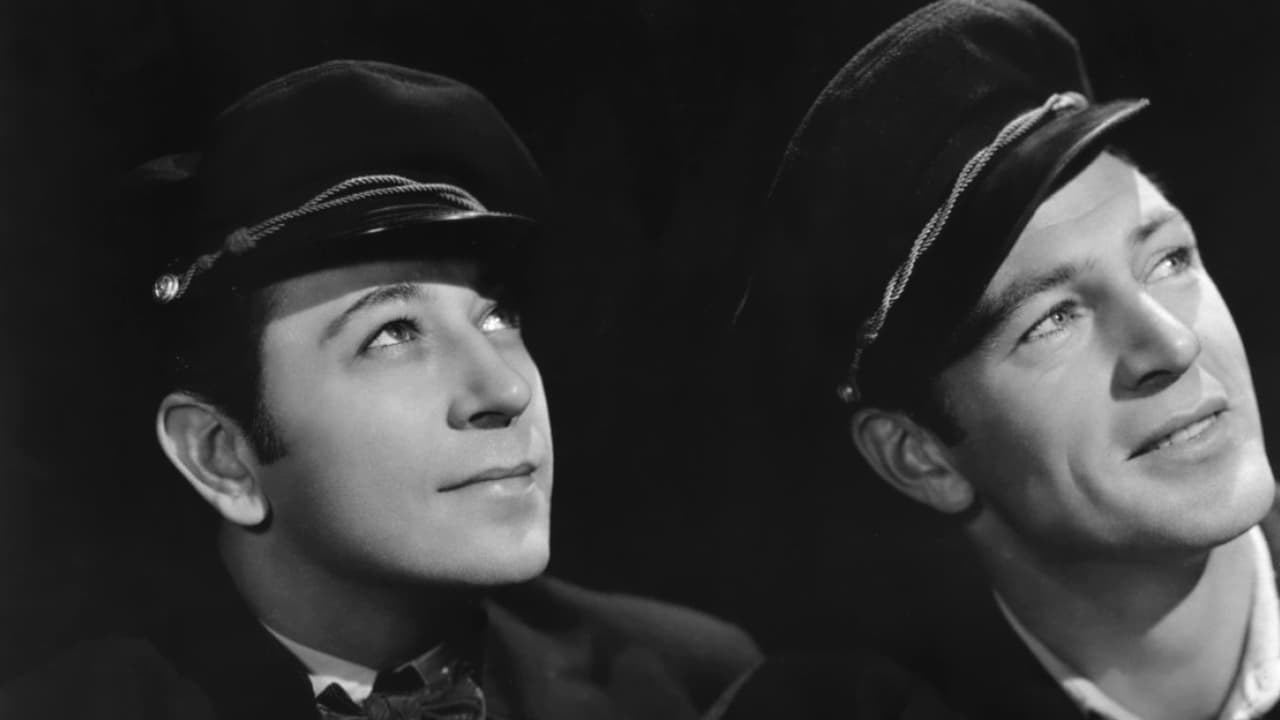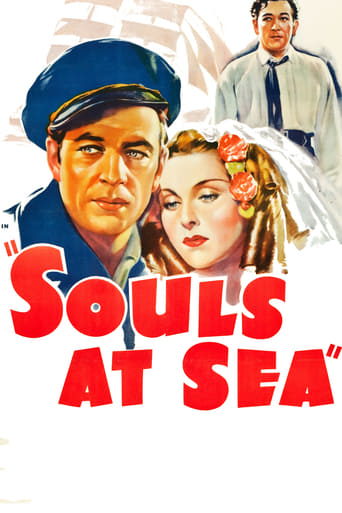Nessieldwi
Very interesting film. Was caught on the premise when seeing the trailer but unsure as to what the outcome would be for the showing. As it turns out, it was a very good film.
Erica Derrick
By the time the dramatic fireworks start popping off, each one feels earned.
Geraldine
The story, direction, characters, and writing/dialogue is akin to taking a tranquilizer shot to the neck, but everything else was so well done.
Kimball
Exactly the movie you think it is, but not the movie you want it to be.
jarrodmcdonald-1
SOULS AT SEA was a rather popular film in its day. So popular in fact that Laurel & Hardy spoofed it in their comedy reworking of the original story, called SAPS AT SEA. So it's a bit unfortunate that this Paramount classic from the late 1930s seems to be slipping into gradual obscurity. It is certainly worthy of repeat viewings and on-going appreciation.The great thing about this production is that the executives at Paramount decided to put two of its biggest male stars at that time into the lead roles. And in fact, it would be the only time that Gary Cooper and George Raft ever appeared in a movie together. They are superb. Meanwhile, Virginia Weidler fans will enjoy seeing her corner the market on tomboys, singing and telling stories– some from books, mostly fibs. And the rest of the supporting cast, particularly Henry Wilcoxon, also help make this an outstanding film.
GManfred
I was hoping for a melodrama instead, but the emphasis here is on the narrative rather than on action. But I am pleased to report that my headline is accurate, because "Souls At Sea" is a very interesting story about a subject barely touched upon in Hollywood's long, colorful history. Reading through other reviewers takes on the film, it qualifies more accurately as a semi-historical drama, although not the first story Hollywood has taken liberties with. The temptation is to call "Souls At Sea" a 'seafaring yarn', but, as I said, it is heavy on talk and light on second unit work.In any case, this offbeat movie has Gary Cooper faced with a moral dilemma as an abolitionist involved in the slave trade in the middle of the 19th century. His sidekick is George Raft, in as sympathetic a role as he ever had and one of his best acting jobs (never one of his strong points). Frances Dee is an ingenue on board the ship in question, and George Zucco plays a good guy for a change. Particularly effective is the background music which won an AA nomination for composer Milan Roder. Henry Wilcoxon is an effective bad guy and Olympe Bradna, whose film appearances were too few, is touching as a maidservant and love interest for George Raft. Very well done, as is the norm with a Henry Hathaway picture. The story is so absorbing that the viewer nearly forgets about the lack of action scenes, and is well worth my rating of seven.
bkoganbing
Paramount was not a studio particularly known for making social commentary in its product. Souls at Sea is an unusual film to come from that particular studio, let alone any studio for very few dealt with the slave trade as an issue.In The Films of Gary Cooper book it mentions that as elaborate as this production was, Paramount had budgeted Souls at Sea for a lot more. Apparently whole sequences involving Cooper's original rescue by the slave ship, a ball at Queen Victoria's court, and some scenes involving capturing slaves were left out. In some lists both Alan Ladd and Ward Bond were listed in the cast and their scenes were edited out.What they left though is both a rousing sea saga and a story about the immorality and inhumanity of the slave trade. It begins in a courtroom where Gary Cooper is on trial for murder on the high seas. A verdict is about to be handed down when George Zucco interrupts the proceedings as a representative of the British government. He tells the court Cooper's real story and the film unfolds in flashback.George Raft is surprisingly good here, usually he's not when he's not either dancing or being a gangster as Cooper's friend. Frances Dee is one pretty Victorian heroine and sister of British officer Henry Wilcoxon who has an agenda all his own.I wasn't surprised to learn that Boris Morros's score for Souls at Sea got an Academy Award nomination. It is particularly lovely and poignant.The climax of the film is a shipwreck at sea and Cooper's actions therein. He has to make some grisly choices, some of the same ones as was previously pointed out that Tyrone Power made in Abandon Ship.The beginning of the film has Gary Cooper seizing an opportunity to save some Africans from becoming slaves. The climax has him saving some other lives in a shipwreck. The point that Director Henry Hathaway was trying to make is that as human beings all of them had an immortal soul and none deserved to be the property of another. The lives saved at the beginning and the end were just as valuable.Souls at Sea holds up well today as good action entertainment with a profound message.
theowinthrop
Our memories of historic calamity is selective - from legend the great flood of Noah (and Gilgamesh), from Rome the eruption of Vesuvius over Pompeii and Herculaneum, from the middle ages the bubonic plague, from the Reformation the St. Bartholemew Day's Massacre, the Great fire of London in 1666, all the way to the Chicago fire, the San Francisco Earthquake, the sinking of the Titanic, the Hindenburg, the Holacaust of World War II, and a handful of others. No films about the Lusitania, the Andrea Doria, the Teneriffe Airplane catastrophe (the worst aviation disaster), the Wilhelm Gustloff, the eruption of Mt. Pelee in Martinique in 1902 (there is a book THE DAY THE WORLD ENDED, which was made into a movie - but the setting was modernized), or the great influeza epidemic of 1918. Occasionally a film briefly deals with a disaster: MANHATTAN MELODRAMA with the the General Slocum fire, or THE SEVEN LITTLE FOYS with the Iroquois Theatre fire. It is rare for a film to pick up and plant a tragedy squarely into the conclusion of a film.In 1842 a ship, the "William Brown", hit an iceberg and sank. The survivors faced a problem similar to the Titanic - there was only one lifeboat, and too many people to save. The Captain (Harry Carey Sr. in this movie) was injured and command went to the first mate. The mate (here played by Gary Cooper) had one of the most agonizing decisions any seaman faces: "Who will live and who must we allow to die?" He went about the grim business with determination, and about a dozen survivors died. The remaining survivors owed their lives to his decision - because he was able to keep the one lifeboat afloat by not overloading it with survivors. However, he was tried for murder, and convicted of manslaughter. The film changes this in several ways. First, the bulk of the film dealt with the slave trade, slowly being made illegal by the British and U.S. governments in the late 1830s and 1840s, but still supported strongly in the American South. Much of the film deals with Cooper and his friend George Raft fighting the slave interests (represented by Henry Wilcoxon - for once away from his usual director Cecil B. DeMille). Secondly, the disaster that culminates the film is caused by a fire set by a little girl (Virginia Weidler - who is killed in the initial explosion). The disaster is well handled, and gives Raft one of his most poignant moments when he takes the body of his girlfriend (who was killed in the disaster) and places the body on her bed in her stateroom, and goes down with the ship to remain with her. The actual choices of death or life is given by Cooper - and done well. Finally, the court does not convict Cooper, who is freed by the eloquence of his lawyer (George Zucco, of all people!). It is a good movie, and reminds the audience of how powerful an economic group the slavers were. Many American fortunes in the shipping trade did use slave ships for profit on occasion. In the 17th, 18th, and early 19th Century it was not considered an obnoxious trade until about 1828. Before condemning Americans for being so hypocritical, remember England did not finally abolish slavery until 1833 (just before the death of William Wilberforce, the man who led the abolitionist movement there for decades). Russia did not abolish it's variation - serfdom - until 1861, four years before the U.S. abolished it with the 13th Amendment, and Brazil did not abolish it until 1889! I might add that in portions of North Africa, it is still countananced by certain governments (like the Sudan). The latter detail does not get much attention in the press, interestingly enough.Why was the "William Brown" tragedy "lucky enough" to get a film of it's own? Why no film about the loss of H.M.S. Royal George (which keeled over with the loss of 900 people at anchor in Spitshead in 1782), or the Andrea Doria (surely an interesting film about the great rescue of 1,600 people on board is worth consideration)? Neither appears on celuloid (although photos and movies of the actual Doria disaster exist). But why the "Brown"? The trial does give the film a good culmination point, but the sinking has nothing to do with slavery or the slave trade!By the way, the story of the "Brown" was repeated in a modern setting in 1957, when Tyrone Power starred in "ABANDON SHIP!". Basically the story is kept the same - overcrowded lifeboat under command of the first mate (Power) when the Captain dies (here the Captain was Lloyd Nolan). The only difference was that Stephen Boyd was the one survivor who tries to stop Power. Power survives, but is put on trial and found guilty of manslaughter. Since his decisions are put into central view, the entire movie deals with the emotional problems Power faces in literal life and death choices. It is a terrific film, and one of Power's three or four best dramatic performances. Footnote to Power and his sea movie - Tyrone Power was the third of four generations of Powers after an initial ancester, also known as Tyrone Power, who made a huge reputation as a leading stage actor of the 1820s and 1830s in England and the United States. His great-grandfather was sailing home, in March 1841, on the largest Atlantic liner of the day: the President. It was last seen in a hurricane swept sea off Nantucket shoals. Nothing further was ever discovered of it. Many Americans found it a sinister coincidence that that April, for the first time in our history, the U.S. President (William Henry Harrison) died in office of pneumonia. Perhaps Tyrone Power thought of his missing forbear when he made ABANDON SHIP, that re-telling of the William Brown tragedy.

